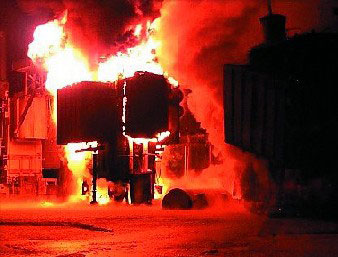Saturated Cores Fault Current Limiter
Fault Current Limiter (FCL)
Background:
In case of a short circuit in a specific segment of the electric network, uncontrolled current flows into the short. This is the fault current or the short circuit current. Fault currents are likely to be many folds higher than the nominal current and may cause severe damage to devices in the electric grid. Since the power is proportional to the square of the current, the extra power generated by the fault currents leads to over heating and sometimes to device burnout. In addition, mechanical forces, which also increase as the square of the current, become significantly higher during a fault event and may result in device tear-off and even in device explosion.

Transformer explosion following fault current event
The ever growing demand and generation of electric power result in a constant increase in fault current levels. The worldwide effort to add renewable energy sources to the power grid, adds its contribution to the increasing fault currents. In addition, one of the goals of the "smart grids" development effort is parallel connection of network segments, which enables energy transfer between sections, balances load requirements and improves network stability and reliability. However, such parallel connection increases the prospective fault current of the joint network up to the sum of the fault currents in the connected segments. Therefore, the fault current problem is a serious barrier to parallel connection of network sections and added renewable energy generation sources.
Present solutions to the fault current problem include circuit breakers, which are capable of disconnecting the fault current. Also, devices in the grid (transformers, for example) are built to exhibit high impedance, which limits the fault current. Reactors are also used in some locations to insert additional impedance to the grid, and the network is segmented to reduce fault currents. However, The above solutions exhibit several drawbacks:
- In many grid locations, the prospective fault current is already above the rated current of circuit breakers therein. Such cases require high-cost infrastructure upgrade.
- The high impedance of transformers and reactors results in high voltage drop and high reactive power. These reduce the stability and reliability of the grid.
- Grid segmentation contradicts the "smart grid" vision where an effort is made to connect networks and allow energy flow between networks.
New Technology - Superconductivity Based Solutions
The discovery of High-Temperature Superconductors (HTS), which enables operating at liquid Nitrogen temperatures, has opened a new window for using HTS for the purpose of fault current limiting. Worldwide effort has begun, aiming at developing fault current limiters based on HTS materials. This R&D effort has focused on two main channels:
 Resistive FCL: The most intuitive solution is to add a superconductor in series with the grid (see the sketch to the left. Credit: accessscience.com). The superconducting element is designed to remain such during normal grid operation, where a nominal current flows through it, and switch to its normal state when the fault current rises and exceeds the critical current of the HTS element. It's the normal state resistance that then limits the current from reaching its prospective value.
Resistive FCL: The most intuitive solution is to add a superconductor in series with the grid (see the sketch to the left. Credit: accessscience.com). The superconducting element is designed to remain such during normal grid operation, where a nominal current flows through it, and switch to its normal state when the fault current rises and exceeds the critical current of the HTS element. It's the normal state resistance that then limits the current from reaching its prospective value.
Many projects around the globe have investigated (and are still investigating) the resistive HTS FCL: In Germany, a 10 KV resistive FCL prototype has been installed and tested in the RWE network [1]. SuperPower Inc. was leading a project for demonstrating a "Matrix" design resistive FCL on a 138 kV power grid of American Electric Power [2]. SuperPower’s team included: Sumitomo Electric Industries Ltd., Nissan Electric Co. Ltd., BOC Group Inc., American Electric Power and Oak Ridge National Laboratory. This project has been terminated without completion. Recently, Nexans, Siemens and American Superconductor Corporationhave announced successful tests of a transmission voltage (138 kV insulation class) resistive fault current limiter (FCL) that utilizes high temperature superconductor (HTS) wire.
Despite the partial success of the resistive type fault current limiter, some of its drawbacks became evident: clearly, as the HTS elements present finite resistance in AC current mode of operation, it is subjected to losses, which require increasing cooling power as the rating of the FCL increases. In addition, the dynamic nature of the transition from superconducting to resistive state and vice versa and the high energy dissipation during the transition makes the recovery of the resistive FCL slow and require a parallel inductive shunt to deflect the high current and allow switching of the HTS element.
 Inductive Fault Current Limiter:
Inductive Fault Current Limiter:
The inductive type FCL is based on a transition between low and high impedance states of the device, which is primarily an inductor. The traditional concept uses a magnetic core screened by a cryogenically cooled HTS element. A primary coil, connected in series with the grid, is wrapped around the HTS screen (see the sketch to the left. Credit: accessscience.com).
"System technology and test of CURL 10, a 10 kV, 10 MVA resistive high-Tc superconducting fault current limiter"
Kreutz, R., Bock, J., Breuer, F., Juengst, K.-P., Kleimaier, M., Klein, H.-U., Krischel, D., Noe, M., Steingass, R. and Weck, K.-H.
IEEE Transactions on Applied Superconductivity, 15, 1961 (2005).
"An Assessment of Fault Current Limiter Testing Requirements"
Brian Marchionini, Ndeye K. Fall, Michael Steurer
Report for the U.S. Department of Energy Office of Electricity Delivery and Energy Reliability (2009).
"Applications of High Temperature Superconductors to Electric Power Equipment"
Swarn S. Kalsi
John Wiley & Sons - Technology & Engineering (2011). Online preview: http://books.google.co.il/books?id=BLuh58_6M1wC



